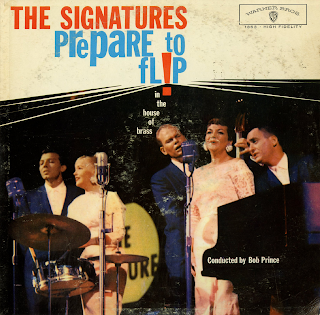Yesterdays
Modern Jazz With Dixieland Roots
Don Stratton
Produced by Creed Taylor
Cover Photography: Fernand Fonssagrives
Cover Design: Fran Scott
Liner Photo: Alan Fontaine
Engineer: Irv Greenbaum
ABC-Paramount ABC-118
1956
From the back cover: The schism that so violently split jazz in the mid-'40s has nearly been healed. A musician or listener didn't have much choice in those days. He either allied himself with the new movement – the be-boppers – or clung fiercely to his family fare and became known as a moldy fig.
Those were the days when an unwary listener who asked a bop group to play Muskrat Ramble might easily be hooted out of the club. And the days when modernists were laughed at with cries of "Chinese music!" and "Fraud!"
But little by little – sometimes almost painfully – the breach has narrowed. Bobby Hackett's talent for playing only the loveliest of notes cannot be ignored, be you the most avid Dizzyite. The genius of Charlie Parker was such that it cut across all party lines.
And then Dixieland bands began almost surreptitiously to hire up-to-date drummers who could swing in two without playing oom-chuck. Young tenor men began to discover that before Stan Getz there was a Lester Young. And before him, Bud Freeman.
It would seem that the day has again arrived where a man is judged on his talents and inventiveness – not on if he takes his drinks at Nick's or at Birdland. Or prefers the compositions of Clarence Williams to those of Gerry Mulligan.
The collection included in this jacket goes a long way toward proving the point that it isn't whether you use tunes which are old or new – it's what you do with them that counts. And that you approach them with open mind.
Don Stratton and Phil Sunkel obviously did just that when they went about adapting these chiefly Dixieland opuses to their own use. First they assembled a group with unique instrumentation, yet one based firmly in jazz history. Two trumpets lead the way here – lead it brightly and weavingly and with sensitive interplay.
And most jazz fans will recall that it was more than 30 years ago that Louis Armstrong joined Joe (King) Oliver's band and produced some thrilling two-trumpet work with Joe that still is remembered with awe by those who heard it.
The two horns here belong to Dn and Phil, and they are played with wide variety of sound and scope, with mutes and without. Abetting them is the muscular tenor saxophone of ex Woody Hermanite, Dick Hafer. Another onetime Herdsman is on piano – Dave McKenna – and the broad background he has had in all of jazz music is readily apparent in his two-fisted playing. Chuck Andrus is the bassist, and behind the drums is Karl Kiffe, an alumnus of such bands as Jimmy Dorsey and Georgie Auld.
This is Stratton's first record date as a leader. Born in Woburn, Mass., in 1928, he stared on trumpet at the age of 7. After high school he minded the band of Nat Pierce, then working around Boston when work was available. He went on to play with Buddy Morrow, Claude Thornhill, and Elliot Lawrance.
Many intent jazz listeners already are convinced that Phil Sunkel, even though sparsely represented on records thus far as a writer-instrumentalist, possess that rare talent of bing alba to write melodic lines of rare beauty and perception, and that he is going to become one of our major talents.
Born in Zanesville, Ohio, in 1926, he graduated from the Cincinnati Conservatory in 1950, then moved to New York, where he played with many bands, including Thornhill, Pastor, Charlie Barnet, Stan Getz, and Sauter-Finegan.
And so, though it might have been deemed an impossibility as few as five years ago, young and perceptive jazzmen of the caliber of Stratton and Sunkel now are probing into material long associated with an older idiom and are adapting it gracefully to their conceptions.
If you need more than the obvious sincerity of these performance and the swinging jazz hat results to prove there is no tongue-in-cheekiness involved, listen to Stratton's R.HJ.S and Wiggling' And Giggling' and see how well the lessons taught by elders have been absorbed by these men in writing, as well as playing. Modern Jazz with Dixieland Roots. – Jack Tracy - Editor, Down Beat Magazine
From Billboard - September 1, 1956: One of the best covers of the season will draw attention to what is actually some pretty sticky jazz. Stratton, far from a modernist, is stiff and often downright corny. Phil Sunkel, a far better jazz trumpeter, is heard in just a few spots. Some of the tunes ("Black Bottom," "Charleston," etc.) would seem to convey the idea of the title. 'Tain't so.
Black Bottom
Royal Garden Blues
Wigglin' An' Gigglin'
Sow Goo Mang
What Is This Thing Called Love?
Personnel on: "Black Bottom", "Wigglin' An' Gigglin", "What Is This Thing Called Love?" - Don Stratton, John Williams, Dick Hafer, Chuck Andrus, Karl Kiffe
Personnel on: "Royal Garden Blues: - Don Stratton, Phil Sunkel, Dave McKenna, Karl Kiffe, Chuck Andrus
Personnel on: "Sow Goo Mang" - Don Stratton, Phil Sunkel, Dave MeKenn, Karl Kiffe, Chuck Andrus
Charleston
Sunday
Yesterdays
Moxahala
R.H.S.
Personnel on: "Charleston", "Yesterdays", "R.H.S." - Don Stratton, Phil Sunkel, Dave McKenna, Karl Kiffe, Chuck Andrus
Personnel on: "Sunday", "Moxahala" - Don Stratton, John Williams, Dick Hafer, Chuck Andrus, Karl Kiffe























